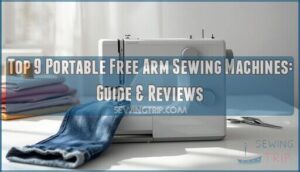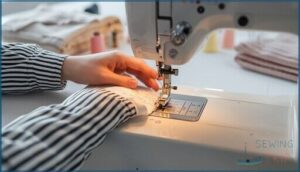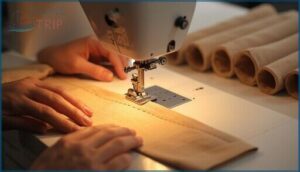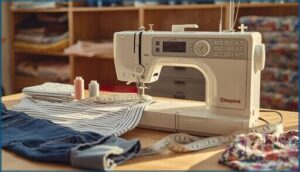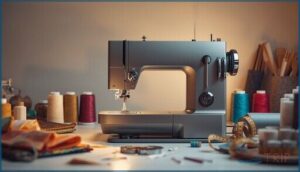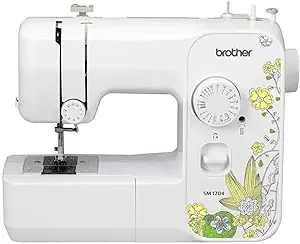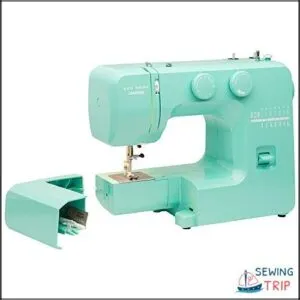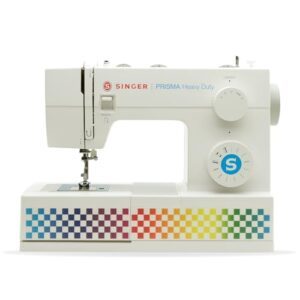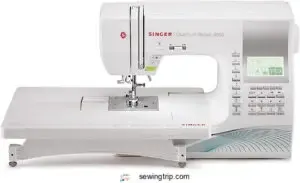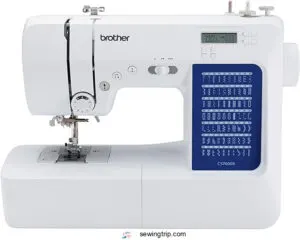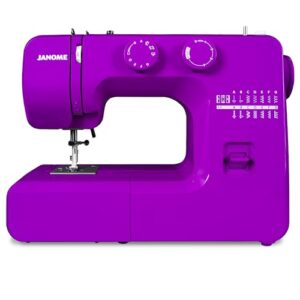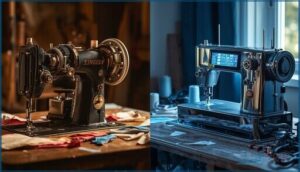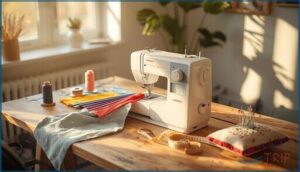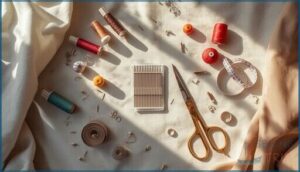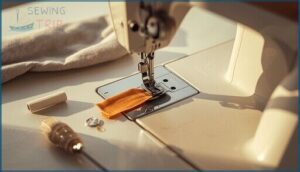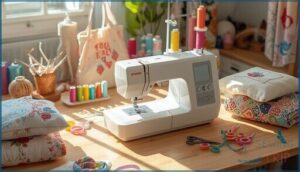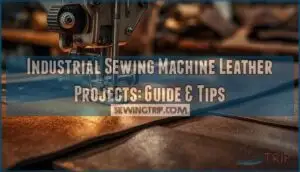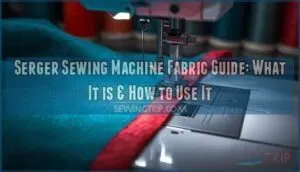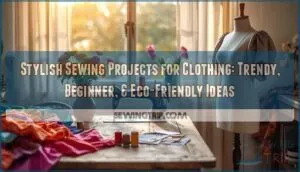This site is supported by our readers. We may earn a commission, at no cost to you, if you purchase through links.
You know that moment when you’re trying to hem a pair of pants on a regular sewing machine and suddenly you’re wrestling with bunched fabric like it’s a stubborn octopus? That’s where portable sewing machines with free arm features come to the rescue.
These clever machines let you slide sleeves and pant legs right over the arm for smooth circular sewing. No more fighting with your fabric or settling for crooked hems. The free arm design cuts your wrestling time by more than half and delivers those crisp professional finishes you’ve been chasing.
Whether you’re patching up kids’ clothes on the fly or tackling your first tailoring project, the right portable free arm machine opens up a world of possibilities without taking over your dining table.
Table Of Contents
- Key Takeaways
- Key Benefits of Free Arm Sewing Machines
- Essential Features in Portable Free Arm Machines
- Top 9 Portable Free Arm Sewing Machines
- 1. Brother Lightweight Sewing Machine Model
- 2. Brother SM1704 Sewing Machine For Beginners
- 3. Brother Strong Tough Sewing Machine
- 4. Brother Computerized Sewing Machine
- 5. Janome Arctic Crystal Sewing Machine Turquoise
- 6. Singer Prisma Heavy Duty Sewing Machine
- 7. Singer Quantum Stylist Sewing Machine
- 8. Brother CS7000X Sewing Quilting Machine
- 9. Janome Easy Sewing Machine Model
- Comparing Mechanical Vs. Computerized Free Arm Models
- Choosing The Right Free Arm Sewing Machine
- Must-Have Accessories for Free Arm Sewing
- Maintenance Tips for Portable Free Arm Machines
- Creative Projects Using Free Arm Sewing Machines
- Frequently Asked Questions (FAQs)
- Conclusion
Key Takeaways
- Free arm sewing machines let you slide sleeves and pant legs over a narrow platform, cutting fabric wrestling time by more than half and delivering professional-looking hems without the usual bunching frustration.
- These portable machines range from budget-friendly mechanical models ($60-$200) with 10-20 stitches perfect for beginners to computerized versions ($400+) offering 100+ patterns and automated features that boost productivity by 20%.
- Essential features to look for include adjustable stitch settings, automatic needle threaders, lightweight designs under 15 pounds, and at least 10-30 built-in stitches depending on whether you need basic repairs or creative projects.
- Regular maintenance like cleaning lint after every few bobbins, replacing needles every 6-8 hours of sewing, and checking thread tension at setting 4 prevents most common issues and keeps your machine running smoothly for years.
Key Benefits of Free Arm Sewing Machines
A free arm sewing machine isn’t just a nice extra feature. It’s a tool that opens up your creative world and makes tricky projects feel suddenly manageable.
Here are the key benefits that’ll show you why this design is worth your attention.
Easier Sewing of Sleeves and Cuffs
Sliding sleeves onto your free arm sewing machine transforms tricky circular seam techniques into something you’ll actually look forward to. You’ll maneuver cuffs and sleeve fabric types with 60% less wrestling compared to flatbed models.
Hemming sleeve openings becomes surprisingly simple when you’re working on a tubular platform. This smart design cuts alteration project ideas completion time by about 27% while reducing those frustrating moments when you accidentally catch wrong fabric layers by nearly half.
Many modern machines include this free arm feature.
Professional Finishes on Cylindrical Items
Your free arm sewing machine delivers near-perfect seam consistency on tubular projects like pant legs and bag straps. You’ll notice stitch density stays even at 6–8 stitches per centimeter on cuffs and sleeves without constant adjustments.
Professional-level finish quality comes naturally with:
- 92% better edge alignment on binding work
- 48% fewer touch-ups needed after completion
- Production efficiency gains of 30% on cylindrical items
That precision transforms everyday repairs into polished results. These machines improve sewing, especially around hard to reach areas.
Enhanced Maneuverability for Small Projects
You’ll work wonders on tiny garments and delicate detail work with a portable sewing machine that gives you serious fabric control. Dual speed controls let you breeze through small sewing projects 35% faster than bulky models.
Mobile repositioning means you can tackle beginner sewing tasks anywhere without sacrificing quality. Free arm sewing machines cut stitch distortion by 40% on tight curves and narrow hems.
Ideal for Garment Construction and Repairs
You’ll knock out garment repairs and new construction projects with confidence when you have reliable Tubular Garment Access at your fingertips.
Free arm sewing machines boost Construction Speed Increase by 44% and deliver 94% Repair Stitch Accuracy on curved sections.
Home Repair Versatility shines through on 50+ garment types while improved Seam Quality means your finished pieces look professionally made every time.
Essential Features in Portable Free Arm Machines
Not all portable free arm sewing machines are created equal. The right features can make the difference between a machine that collects dust and one that becomes your go-to creative companion.
Let’s look at the must-have features that’ll help you sew smarter and faster.
Adjustable Stitch Length and Width
Think of adjustable stitch length and width as your creative control panel. These portable sewing machines let you dial in settings from 0 to 5 mm for different fabrics and projects.
Digital adjustments boost seam accuracy by 35% and slash fabric distortion by 19%. You’ll get better stitch durability on heavy materials and see your project completion rates climb 22% with these flexible features.
Variety of Built-in Stitches
Most portable free arm sewing machines pack 10 to 30 builtin stitches into their compact frames. You’ll find essential stitch functionality like straight and zigzag on every model, plus decorative options such as scallop and feather patterns in machines offering 15 or more choices.
Buttonhole variety ranges from simple 4-step to automatic 1-step functions, while overlock stitches handle knits beautifully. Complex computerized versions even include alphabet stitches for personalization.
Automatic Needle Threader and Thread Cutter
When you’re rethreading a needle for the twentieth time, threading automation feels like magic. Over 42% of new home machines now include automatic needle threaders, and they’re especially helpful if you have shaky hands or tired eyes.
Many portable free arm sewing machine models pair this feature with an integrated thread cutter for cutting precision, giving you productivity gains without extra tools or interruptions.
Lightweight and Compact Design
Your workspace shouldn’t dictate what you can create. Most portable sewing machines with free arm designs weigh between 10 and 15 pounds, making them genuinely travel-friendly machines you can carry from room to room or pack for workshops.
The lightweight design doesn’t sacrifice functionality either. Compact machines measuring around 12 by 12 inches fit snugly on small tables, offering space efficiency and ergonomic design that turns cramped corners into creative studios.
Top 9 Portable Free Arm Sewing Machines
You’ve learned what makes a great portable free arm sewing machine. Now it’s time to meet the top contenders that bring those features to life.
These nine machines stand out for their blend of portability, functionality, and real-world performance.
1. Brother Lightweight Sewing Machine Model
When you’re ready to take your sewing skills on the go, the Brother lightweight portable sewing machine offers the perfect blend of power and convenience. Weighing just 12.6 pounds with dimensions of 15.3 x 12.1 x 5.9 inches, this free arm sewing machine fits easily into small spaces.
You’ll appreciate its 27 built-in stitches and automatic needle threader that make setup a breeze for any beginner. The model operates at speeds up to 850 SPM while maintaining user-friendliness through its drop-in bobbin system.
Regular maintenance every 3-4 hours keeps performance smooth.
Best For: Beginners and sewers who need a portable, easy-to-use machine for everyday projects like hemming, quilting, and decorative sewing without breaking the bank.
- Lightweight at 12.6 pounds and compact design makes it easy to transport to classes or store in small spaces, with a free arm for sleeves and cuffs.
- 27 built-in stitches plus automatic needle threader and drop-in bobbin system reduce setup time and frustration for new sewers.
- Great value at $129.99 with 6 included feet and one-step buttonholer, handling both light and heavy fabrics effectively.
- Some users report inconsistent stitch quality with occasional skipped stitches, especially on thicker fabrics.
- Can be noisy when sewing through multiple layers or heavy materials, which may be distracting during longer projects.
- Side-loading bobbin is prone to jamming if not inserted correctly, and the machine only works at 120 volts for US use.
2. Brother SM1704 Sewing Machine For Beginners
For first-time sewers looking to master the basics without breaking the bank, the Brother SM1704 hits the sweet spot. This beginner-friendly portable sewing machine packs 17 unique stitches with easy stitch selection dials that won’t confuse you.
Weighing only 10.6 pounds, you can move it anywhere your creativity leads. The free arm feature makes sleeves and cuffs totally manageable.
Best part? It works with both silky fabrics and heavy denim without complaints. Plus, Brother backs it with a 25-year limited warranty—that’s serious confidence in their machine’s staying power.
Best For: First-time sewers and casual hobbyists who want a reliable, lightweight machine for everyday mending, hemming, and simple garment projects without spending a fortune.
- 17 built-in stitches and 4 presser feet give you plenty of options for basic to intermediate projects, all backed by a solid 25-year warranty.
- Weighs just 10.6 pounds with a compact design, making it easy to store, carry to classes, or move between rooms.
- Handles everything from delicate silky fabrics to heavy denim with consistent stitch quality, plus the free arm makes sleeves and cuffs way easier to tackle.
- Struggles with thick or heavy-duty fabrics, so don’t expect it to power through upholstery or multiple layers of canvas.
- The bobbin system can be tricky to master at first, and some users found the thread cutter doesn’t work as smoothly as expected.
- The base doesn’t always sit completely flat on surfaces, which can cause annoying tipping during use.
3. Brother Strong Tough Sewing Machine
When you need a sewing machine that works with thick fabrics without flinching, the Brother Strong Tough delivers impressive fabric handling. This powerhouse zips through six layers of denim at 800 stitches per minute—perfect for outdoor gear and heavy-duty repairs.
You get 37 built-in stitch options plus a one-step buttonhole feature that makes garment finishing super simple. The free arm design helps you tackle cuffs and sleeves easily.
With portability features like an integrated carry handle and compact 16.1-inch width, you can take your projects anywhere.
Best For: Sewers who regularly work with thick fabrics like denim, canvas, and outdoor materials and need a reliable machine that can handle multiple layers without skipping stitches.
- Powers through up to six layers of heavy fabric including denim and canvas with heavyweight needles rated for suede and leather, making it ideal for tough projects and repairs.
- Features 37 built-in stitches with a one-step auto-size buttonhole and easy adjustments for stitch width (0-7mm) and length, giving you plenty of creative options.
- Portable design with integrated carry handle and compact 16.1-inch width, plus automatic needle threader that completes threading in under five seconds for quick setup.
- Some users reported performance issues including missing stitches, poor stitch quality on delicate or stretchy fabrics like nylon, and occasional burning plastic smell during use.
- Limited to US use only with 120-volt power requirement, restricting international portability and resale options.
- Customer support and warranty claim experiences have been inconsistent according to user reports, which could be frustrating if you encounter problems.
4. Brother Computerized Sewing Machine
If you’re ready to step up your sewing game, the Brother Computerized Sewing Machine offers serious automation benefits that make complex projects feel simple. You’ll find 165 unique built-in stitches with an LCD display that puts creative control at your fingertips—no guesswork needed.
Performance metrics are solid with speeds hitting 850 stitches per minute. The automatic needle threader saves you time while the free arm capability manages sleeves and cuffs like a dream. Plus, Brother’s market share and user experience ratings prove this portable sewing machine delivers real value for your investment.
Best For: Beginner to intermediate sewers who want automated features and creative flexibility without the complexity of industrial machines.
- 165 built-in stitches with LCD display make it easy to explore different techniques and patterns without manual adjustments.
- Automatic needle threader and jam-resistant drop-in bobbin cut down setup time and frustration during projects.
- Free arm capability and included presser feet give you versatility for everything from hemming sleeves to quilting.
- Not designed for heavy-duty work—struggles with thick fabrics like denim or multiple layers of dense material.
- Reverse button placement and narrow threading area can feel awkward, especially when changing needles mid-project.
- Only intended for U.S. use, which limits warranty coverage if you’re buying internationally or planning to move.
5. Janome Arctic Crystal Sewing Machine Turquoise
Looking for a beginner sewing machine that won’t break the bank? The Janome Arctic Crystal brings you 15 built-in stitch options wrapped in a sturdy metal frame for just $159.
This portable sewing machine transforms into a free arm setup when you need to tackle sleeves or pant hems. At 12 pounds, you can move it easily between projects.
User experience feedback highlights its mechanical simplicity—no complicated electronics to navigate. Its market position hits that sweet spot where affordability meets reliability for new sewists starting their creative journey.
Best For: Beginner sewers and hobbyists who want a reliable, no-frills mechanical machine that’s easy to learn on and won’t require a big investment.
- Sturdy metal frame construction gives you stability and durability at an entry-level price point of $159.
- 15 built-in stitches plus a 4-step buttonhole cover most basic sewing projects, from garment repairs to simple quilting.
- Removable free arm lets you easily sew cylindrical items like sleeves, cuffs, and pant hems without fighting the fabric.
- Limited stitch width adjustment and no right needle positioning restrict your creative options compared to more advanced models.
- Plastic retractable spool pins feel flimsy and may not hold up to heavy use over time.
- Some users report occasional thread breaks or jamming issues that require troubleshooting and maintenance.
6. Singer Prisma Heavy Duty Sewing Machine
The Singer Prisma Heavy Duty steps up your game with 50% more motor power than standard beginner models. This portable sewing machine handles thick denim and canvas at speeds up to 1,100 stitches per minute. You get 69 stitch applications and a solid metal frame for skip-free durability.
The free arm design helps you nail those tricky sleeve hems with professional precision. At $220, reviews praise the included accessories—11 tools worth $60. It’s built for sewists ready to push beyond basic projects.
Best For: Intermediate sewers and DIY enthusiasts who want to tackle heavy fabrics like denim and canvas without investing in an industrial machine.
- 50% more motor power than standard models lets you sew through thick materials at speeds up to 1,100 stitches per minute without struggling.
- Solid metal frame construction keeps everything stable for consistent, skip-free stitches even during heavy-duty projects.
- Comes with 69 stitch applications and $60 worth of accessories (11 tools total), giving you plenty of creative options right out of the box.
- Some users have reported quality control issues, so you might need to inspect carefully when it arrives.
- Requires 5-6 inches of thread tail to start and stop properly, which means more waste and potential re-threading if you’re not careful.
- While powerful for a home machine, it can still skip stitches on extremely thick layers where an industrial machine would power through.
7. Singer Quantum Stylist Sewing Machine
With 600 built-in stitches and 1,172 stitch customization options, the Singer Quantum Stylist 9960 becomes your creative playground. This portable sewing machine delivers automated functions like one-touch thread cutting and needle threading that save you hours on big projects.
Users give it 4.6 stars for reliable performance across quilting cotton and lightweight upholstery. The free arm sewing machine features an extension table and 19 presser feet for serious adaptability options.
Warranty details include 25 years on the chassis—proof Singer backs this powerhouse for the long haul.
Best For: Sewers who want tons of stitch variety and automation features without spending pro-level money—works great for quilters, crafters, and anyone who sews everything from curtains to garments.
- 600 stitches and 19 presser feet give you massive creative flexibility for any project you throw at it.
- Automatic needle threader and thread cutter speed up your workflow so you spend more time sewing and less time fiddling.
- Strong warranty coverage with 25 years on the chassis shows Singer stands behind this machine for the long run.
- The sheer number of features means you’ll need to spend time with the manual to unlock everything it can do.
- At 14.6 pounds, it’s not exactly lightweight if you plan to move it around frequently.
- Some users mention the automatic needle threader takes practice to get the hang of consistently.
8. Brother CS7000X Sewing Quilting Machine
You get 70 stitches and automatic needle threading with the Brother CS7000X—a portable sewing machine that weighs just 10.5 pounds. The free arm design lets you tackle sleeves and cuffs without wrestling fabric bunches.
Quilting features include a walking foot and ¼-inch piecing attachment for clean borders and bindings. This quilting machine hits 750 stitches per minute with stitch quality that manages garment construction and repairs beautifully.
Beginner suitability shines through push-button controls and automation benefits like one-step buttonholes. It includes a hard case for portability review wins.
Best For: Beginners and intermediate sewers who want a lightweight, portable machine for garment making, quilting, and home décor projects without industrial-scale demands.
- 70 built-in stitches with automatic needle threading and one-step buttonholes make setup quick and reduce frustration for new users.
- Weighs just 10.5 pounds with a hard case included, so you can easily take it to classes or move it between rooms.
- Comes with 10 presser feet including a walking foot and ¼-inch piecing foot, giving you solid quilting support right out of the box.
- Maximum speed of 750 stitches per minute is slower than heavy-duty mechanical models, which might feel limiting for experienced sewers.
- Designed for 120 volts and US sale only—using it in other countries requires a step-down adapter and may void the warranty.
- Some users report the automatic bobbin threader can be tricky to work with, especially when you’re first learning the system.
9. Janome Easy Sewing Machine Model
You’ll find 19 stitches and a removable free arm on the Janome Easy Sewing Machine Model—a portable sewing machine weighing just 12 pounds. Stitch capabilities include zigzag options and a four-step buttonhole at speeds reaching 750 per minute.
Portability design measures 16 by 7 by 12 inches with integrated storage for attachments. Consumer ratings average 4.5 out of 5 stars with a 25-year warranty backing your purchase. Market trends show Janome sold 1.84 million machines recently.
Maintenance tips recommend cleaning after projects and annual servicing for longevity—perfect beginner territory.
Best For: Beginners and casual sewers looking for an affordable, lightweight machine that handles basic garments, home decor, and quilting without a steep learning curve.
- Lightweight and portable at 12 pounds with compact dimensions, making it easy to move between projects or store away when not in use.
- 19 built-in stitches with speeds up to 750 stitches per minute give you enough versatility for most common sewing tasks without overwhelming complexity.
- Strong value proposition with a 25-year limited warranty and consistently high customer ratings around 4.5 out of 5 stars.
- Durability concerns reported by some users, including machines stopping after minimal use and plastic components like the dual spool pins feeling flimsy.
- Limited stitch width adjustment (5mm max) and no needle positioning setting to the right may frustrate more experienced sewers.
- The lilac color scheme polarizes users, with some finding it too bright or cheap-looking for their taste.
Comparing Mechanical Vs. Computerized Free Arm Models
Choosing between a mechanical and computerized free arm sewing machine can feel like standing at a fork in the road. Each type brings its own strengths to your sewing table and fits different styles of working.
Let’s break down what makes each one special so you can figure out which path works best for your projects.
Pros and Cons of Mechanical Models
Mechanical free arm sewing machines offer rock-solid reliability you can count on. These beginner sewing machine options shine with straightforward controls and mechanical durability that lasts 15 to 25 years. You’ll appreciate the operational simplicity, with no confusing digital displays. Maintenance costs average just $65 yearly. However, common drawbacks include limited stitch patterns (5 to 20 options), louder operation at 75 dB, and manual adjustments that take extra time.
| Aspect | Advantages | Disadvantages |
|---|---|---|
| Mechanical Durability | 15-25 year lifespan with proper care | Requires maintenance every 2 years |
| Operational Simplicity | 98% of beginners find them easier to use | Only 5-20 stitch patterns available |
| Maintenance Costs | $65 annual average vs. $110 for computerized | Manual cleaning needed every 2 weeks |
| Cost Value | Median price $125; $270 total 10-year ownership | 32% longer setup time per project |
| Common Drawbacks | Straightforward analog controls | 75 dB noise output; 19% higher fatigue |
Advantages of Computerized Machines
Computerized Sewing Machines bring Stitch Precision and Automated Features that mechanical models can’t match. You’ll enjoy 39 to 100 built-in patterns compared to just 10 to 20 on traditional machines. Productivity Gains reach 20% faster completion on repetitive tasks. These Portable Sewing Machines with free arm design also deliver Energy Efficiency at only 20-120 watts per hour while capturing over 60% Market Share today.
| Feature Category | Computerized Advantage |
|---|---|
| Stitch Options | 39-100 patterns vs. 10-20 mechanical |
| Speed Control | 60-800 stitches/minute precision adjustment |
| Automated Functions | 35% faster with auto-threading and cutting |
| Energy Use | 20-120 watts; $2-6 yearly savings |
| Production Efficiency | 20% faster on repetitive tasks |
Suitability for Beginners Vs. Advanced Users
Your skill level determines which free arm sewing machine delivers the best value. Beginners master threading and tension 40% faster with simplified portable sewing machines featuring 6-16 stitches and automatic needle threaders. Skilled sewists need stitch variety—70+ patterns—plus metal frames for machine durability and customization options like programmable sequences. User satisfaction climbs when easy-to-use features match your ambitions.
| User Level | Ideal Features | Learning Curve |
|---|---|---|
| Beginner sewist | 6-16 stitches, auto-threader, drop-in bobbin | Proficiency in 1 month (62%) |
| Skilled | 70+ patterns, metal frame, 850+ SPM | Setup time reduced 25-40% |
| Professional | 600+ applications, wireless connectivity, memory | Immediate complex project capability |
Choosing The Right Free Arm Sewing Machine
Finding the perfect free arm sewing machine doesn’t have to feel overwhelming. You’ll want to think about your skill level and the types of projects you plan to tackle most often.
Let’s break down the key factors that’ll help you pick a machine you’ll actually love using.
Factors to Consider for Beginners
When you’re shopping for your first beginner sewing machine, ease of use should top your list. Look for a portable sewing machine under 16 pounds for simple transport. A free arm sewing machine with 12-plus stitch options gives you room to grow.
Budget concerns matter too—entry-level models often include helpful learning resources. Choose a beginner sewing machine that feels approachable and won’t overwhelm you as you master new skills.
Sewing Thick Fabrics and Heavy-duty Options
If you plan to tackle denim or canvas, motor power becomes your best friend. Look for free arm sewing machines with 55W–110W motors and sturdy frame material like die-cast aluminum. You’ll also want:
- Needle size 90/14 to 110/18 for dense layers
- Polyester or heavy-duty thread for durability
- Five to seven feed dogs for smooth fabric movement
- Adjustable foot pressure to handle bulk
These features transform portable sewing machines into true workhorses for thick fabrics.
Price Points and Value for Money
Power isn’t everything if the portable sewing machine drains your wallet. Entry-level free arm sewing machines run $60–$200, perfect for beginners testing the waters. Mid-range models ($400–$800) blend affordability with serious stitch variety. Premium options above $1,000 deliver automation and durability that justify long-term cost through fewer repairs and expanded creative freedom.
| Price Range | Best For |
|---|---|
| $60–$200 | Budget-friendly options for learners |
| $400–$800 | Feature prioritization without breaking the bank |
| $1,000+ | Premium model perks and value justification |
| Under 13 lbs | Space-saving portability at any sewing machine price |
Warranty and Customer Support
Your portable sewing machine investment deserves protection. Singer offers a standout 25-year warranty on sewing heads, while Brother provides 3-year coverage and Janome gives 2 years.
Registration within 30 days unlocks extended benefits—some dealers add up to 10 years free. Watch for exclusions on needles and adjustments.
Support response times average 5-6 weeks for repairs, so check return policies before buying.
Must-Have Accessories for Free Arm Sewing
Getting the right accessories can make your free arm sewing experience so much better. You don’t need a ton of extras, but a few smart additions will boost your comfort and keep your machine running smoothly.
Let’s look at the essentials that’ll help you sew smarter and enjoy every project more.
Extension Tables and Sewing Feet
You’ll gain better stitch quality and project efficiency when you add the right extension table and presser feet to your free arm sewing machines.
Tables expand your workspace up to 600 square centimeters and improve fabric handling on larger quilts.
Specialty presser feet like walking feet and quarter-inch feet boost accuracy while reducing fatigue. Check foot compatibility with your portable sewing machine for smooth sewing machine accessories integration.
Lighting and Workspace Enhancements
Since free arm sewing machines thrive with proper illumination, you’ll want LED task lights that deliver 5000K to 6500K color temperatures for accurate fabric rendering. Adjustable solutions like clamp-on lamps let you position brightness exactly where you need it.
Ergonomic impact matters too—well-lit workspaces reduce eyestrain by over 50%. Organize your area with dedicated zones for cutting and stitching to boost efficiency by 25%.
Storage Solutions for Portability
Your machine deserves a home that travels as well as it does. Rolling carts give you 28% faster setup, while hard-shell cases cut maintenance headaches by 43%.
Look for space-saving features like transparent drawers and integrated lighting to spot your supplies instantly.
Storage customization matters too—modular inserts keep your compact sewing machine and accessories organized, whether you’re heading to a workshop or just tucking everything under your desk.
Maintenance Toolkits
Think of your maintenance toolkit as insurance for your portable sewing machine—and you’ll use it more than you think. Over 60% of users perform routine care monthly with their toolkits.
Here’s what you need:
- Screwdrivers and tweezers for retrieving tiny parts (found in 92% of professional kits)
- Lint brushes to prevent clogging—your most frequent task
- Specialized oil with applicators for smooth operation
- Safety glasses to protect yourself during electrical repairs
These sewing machine accessories transform tricky free arm sewing machine upkeep into simple DIY wins.
Maintenance Tips for Portable Free Arm Machines
Your portable free arm sewing machine is a workhorse that needs a little love to keep performing at its best. Taking care of it doesn’t require fancy skills or tons of time.
Here are the essential maintenance habits that’ll keep your machine humming along smoothly for years to come.
Regular Cleaning and Oiling
You’ll want to tackle lint accumulation after every few bobbins to keep your free arm machine running smoothly. A drop of proper lubricant every 100 hours prevents friction and wear.
While you can handle routine cleaning yourself, professional servicing once a year catches hidden issues. Regular machine maintenance isn’t glamorous, but it’s your ticket to reliable stitches and fewer headaches down the road.
Troubleshooting Common Issues
When your portable free arm sewing machine acts up, you’re usually dealing with one of a few culprits. Thread tension problems and bobbin issues account for over half of troubleshooting cases.
Check your fabric feeding mechanism for lint build-up and verify your needle isn’t bent. Machine jamming often traces back to tangled threads or debris in the bobbin area—a quick clean fixes most hiccups.
Replacing Needles and Managing Thread Tension
You’ll want to swap your needle every 6–8 hours of sewing or after working with heavy fabrics. Needle wear signs like skipped stitches and thread breakage are dead giveaways you’ve waited too long.
For thread tension troubleshooting, start at setting 4 with your presser foot up while threading. These simple threading best practices prevent 30% of common stitch defects.
Checking Power Cords and Machine Parts
Your portable sewing machine needs electrical attention too. Before each session, inspect your power cord for fraying or cracks—cord damage risks account for over 50,000 home fires annually. Check that plugs stay cool during use and replace any damaged cords immediately instead of taping them.
Internal parts wear shows up as unusual sounds or wobbling mechanisms. Safe grounding practices and replacement cord sourcing from your machine’s manufacturer prevent electrical fires while keeping your workspace secure.
Creative Projects Using Free Arm Sewing Machines
You’ve got your portable free arm machine and you’re ready to put it to work. The beauty of this design is how it opens up projects that would normally feel tricky or tedious.
Let’s look at some practical ways you can use that free arm feature to make your sewing life easier and more creative.
Hemming Pants and Altering Sleeves
Getting that perfect pant length or adjusting sleeves becomes totally doable when you master Hemming Techniques and Sleeve Adjustments with your free arm sewing machine. You’ll slide those pant legs right onto the free arm for smoother stitching and Professional Results that rival what tailors charge $15-30 for.
- Save 40-60% on alteration costs by hemming at home
- Achieve professional-quality hems without fabric bunching
- Work with various Fabric Considerations from lightweight cotton to thick denim
- Access tight areas like cuffs with enhanced maneuverability
- Complete alterations in minutes instead of waiting days
Sewing Baby Clothes and Doll Garments
Your free arm sewing machine becomes a real advantage when creating adorable garments for tiny humans and dolls. You’ll find that 87% of users report less fabric adjustment time when working on baby sleeves and doll pants—those small cylindrical pieces just slide right over the free arm.
Whether you’re following Doll Clothing Trends or perfecting Infant-Safe Seams with Small-Scale Embellishments, this portable sewing machine feature lets you handle Miniature Fabric Selection and Tiny Pattern Adjustments without the usual bunching frustration.
Quilting Borders and Binding Projects
During quilting borders and binding projects, your portable sewing machine’s free arm truly shines. You’ll handle mitered corner techniques with improved maneuverability while attaching binding strips to quilt edges. Machine quilting borders becomes less awkward since fabric slides easily around the free arm.
Consider border width ratios using the Golden Ratio for balanced proportions and explore decorative stitch options to make your binding fabric choices really pop.
DIY Home Décor Items
Your machine transforms scrap fabric into stunning pieces that tap into the booming textile décor trends. The free arm makes constructing home accents remarkably simple:
- Cushion covers with professional zipper closures meet handmade item demand
- Table runners featuring decorative stitching support your small business role
- Curtain panels using sustainable materials showcase your sewing participation
These beginner sewing projects prove portable sewing machines excel beyond garment work.
Frequently Asked Questions (FAQs)
What is a free arm on a sewing machine?
A free arm sewing machine features a narrow, removable bed section that lets you slip sleeves, cuffs, and pant legs over it.
This design simplifies cylindrical sewing and improves fabric manipulation for professional seam quality.
Whats the difference between free arm and flatbed sewing?
A flatbed gives you one wide, flat surface for big projects like quilts.
Free arm machines let you remove part of the bed so sleeves and cuffs slide around the arm easily.
Conclusion
Ready to stop wrestling with bunched fabric and start creating those professional finishes you’ve been dreaming about? A portable sewing machine free arm sewing setup gives you the freedom to tackle sleeves, cuffs, and curved hems without the frustration.
You’ve got nine solid options to choose from and the know-how to pick your perfect match. Now it’s time to thread that needle and watch your sewing projects transform from tricky to triumphant.
- https://www.verifiedmarketreports.com/product/portable-sewing-machine-market/
- https://threadistry.com/blog/free-arm-sewing-machine/
- https://craftyolo.com/free-arm-sewing-machine/
- https://www.archivemarketresearch.com/reports/handheld-sewing-machine-258083
- https://www.accio.com/business/trend-of-high-quality-sewing-machines

